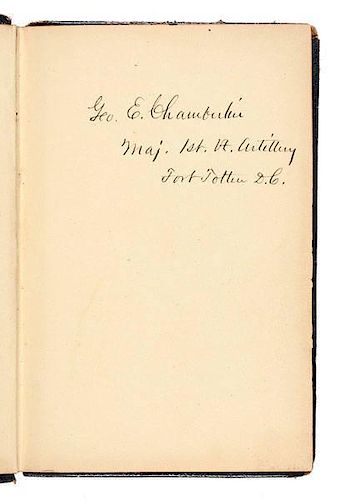Maj. George E. Chamberlin, 1st VT Heavy Artillery, Journal Including Sketches of Fortifications Built as Part of the Defenses of Washington, D.C.
About Seller
6270 Este Ave.
Cincinnati , OH 45232
United States
With offices in Cincinnati, Cleveland and Denver, Cowan’s holds over 40 auctions each year, with annual sales exceeding $16M. We reach buyers around the globe, and take pride in our reputation for integrity, customer service and great results. A full-service house, Cowan’s Auctions specializes in Am...Read more
Two ways to bid:
- Leave a max absentee bid and the platform will bid on your behalf up to your maximum bid during the live auction.
- Bid live during the auction and your bids will be submitted real-time to the auctioneer.
Bid Increments
| Price | Bid Increment |
|---|---|
| $0 | $25 |
| $500 | $50 |
| $1,000 | $100 |
| $2,000 | $250 |
| $5,000 | $500 |
| $10,000 | $1,000 |
| $20,000 | $2,500 |
| $50,000 | $5,000 |
| $100,000 | $10,000 |
About Auction
Jun 13, 2014 - Jun 14, 2014
Cowan's Auctions dawnie@cowans.com
- Lot Description
Sketchbook with seven drawings. Ca 1863.
A native of St. Johnsbury in far-northern Vermont, George Chamberlin was born June 30, 1838. Educated at the St. Johnsbury Academy, Dartmouth College (1860), and Harvard Law (1862), he postponed his career plans to respond to Lincoln's call for 300,000 volunteers during the summer of 1862.
Still only 24 years old, Chamberlin was commissioned as Captain in the 11th Vermont Infantry, a unit which was later redesignated the 1st Vermont Heavy Artillery, but within days he received a promotion to Major and later to Lt. Col. Most of his service was performed with the heavy guns that graced the ring of forts surrounding Washington, D.C., commanding Forts Totten and Lincoln in succession. According to an account in the Vermont Journal (Jan. 7, 1865) Chamberlin earned a reputation for instilling proper military discipline in his commands: "To Chamberlin, (then Major), fell the command of Fort Totten. And the fort, with its surroundings, at first rude and incompetent, at length, under his directing hand, finished and invested with an air of neatness and beauty, stands today an enduring memorial of his excellent taste, good judgment, perseverance and discipline, and fidelity to the responsible trust committed to his care."
After lengthy, relatively uneventful service, the 1st Vermont Heavy Artillery was called into emergency action on May 12, 1864, taking hurried part in the horrific engagements at Spotsylvania, Cold Harbor, and Petersburg, before moving into the Valley Campaign that fall. While leading a skirmish line at Charlestown, WV, on Aug. 21, 1864, Chamberlin became one of 32 casualties sustained by his regiment that day. Shot through the abdomen, he died of his wounds the next day in the hospital at Sandy Hook, MD.
This delicate sketchbook shows the precision and care that marked Chamberlin's time in service at Washington, D.C. Signed by Chamberlin on the free front end paper at Fort Totten, it includes seven sketches in pencil and ink with tissue paper guards, some with caption on opposite page, and at the end of the volume are tables for ranges of 24 pound siege guns and 32 pound coast guns, 8 inch siege howitzers. The drawings include:
1. Plan of fortification showing gun emplacements, magazine, and powder magazine
2. Roads and terrain around Fts. Bunker Hill and Slemmer
3. Roads and terrain around Fts. Bunker Hill, Saratoga, and Thayer
4. Unidentified location
5. Roads and terrain around Fts. Slocum and Stevens, hospital
6. Ditto
7. Terrain near Rock Creek Church and rectory
Apart from the plan of fortifications, the drawings are all topographical drawings of the terrain, probably as seen from Fort Totten, with roads and significant buildings carefully noted. Most of the structures depicted on the maps are labeled with a number, probably representing the distance of the structure in yards. The sketches are immaculate and intricately detailed, made on the pages of a high quality autograph album, leather bound with tooled gilt decoration on cover and spine.A one centimeter piece is lacking from the head of the album's spine and approximately 2 cm from the tail; some shelf wear and rubbing at extremities, but internally very clean and attractive.Condition
- Shipping Info
-
SHIPPING. At the request of the buyer, Cowan's will authorize the shipment of purchased items. Shipments usually occur within two weeks after payment has been received. Shipment is generally made via UPS Ground service. Unless buyer gives special instructions, the shipping method shall be at the sole discretion of Cowan's Auctions, Inc.. Cowan's is in no way responsible for the acts or omissions of independent handlers, packers or shippers of purchased items or for any loss, damage or delay from the packing or shipping of any property.
-
- Buyer's Premium



 EUR
EUR CAD
CAD AUD
AUD GBP
GBP MXN
MXN HKD
HKD CNY
CNY MYR
MYR SEK
SEK SGD
SGD CHF
CHF THB
THB










